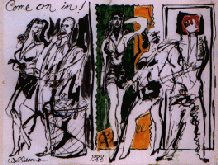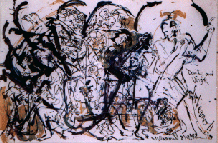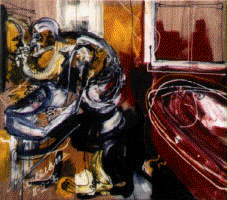Please select any image. By clicking on that image, an enlarged image will form. Please be patient while the full images download.
Comments? Insults? Offers? Please?
Is there a way to explain these kinds of catastrophes? Let me try...perhaps poorly. I don't remember ever not drawing. But I do remember learning how to draw from comic books. I was attracted to the 1940's to 1950's Batman comics stories I saw in yearly reprint editions called "80 Page Giants". I was fascinated by an artist whose name I didn't know at the time but I know now: Dick Sprang. His people were cartoony; fluid lines quickly, convincingly conveyed their dramatically over the top, yet somehow subtle, moral content. They existed in deep, fall up to the ceiling perspective; surrounded by huge machines and giant everyday objects (movie props, museum artworks, etc.), drawn simply but solidly with an attention to convincing detail. Gotham City was a glittering, city lights at night cosmopolis, and if the Dadaists had ever decided to plan bank heists instead of attacking the artworld, they would have admired the view in Gotham (and been welcomed in the criminal underworld as well. The best villains were always aesthetes). Sometimes I look at these old comics and am surprised how short a distance I have come; how much that artwork resembles my own.
Who are my influences? Let me list, in terms of both attitude and artist: the agony of Edvard Munch; the aching of Edward Hopper; the urbanity of Jasper Johns; the mysticism of Grunewald; the mystery of Leonardo; the wit of Robert Rauschenberg; the passion of Willem De Kooning; the luxury of Matisse; the hipness of Stuart Davis; the irony of Charles Demuth; the worldliness of Picasso; the sarcasm of Marcel Duchamp. And, of course, Dick Sprang. But there are more: the scholastic blood and marrow of Dante, the lugubrious anxiety of Dickens, the inexorable despair of Melville, the wry sneer of Twain, the transparent mystery of Flannery O'Connor, and the lonesome traveling of Bob Dylan.
Pictorially, I have sought to use my daily sight as my starting point, albeit in a rather jagged manner: tar patches in roads, layered dust and dirt in the backs of trucks, company logos and messages, power wires and shadows and electric cords and beer spills, tree branches and lightening, broken glass and cracks in the sidewalk. I claim these as antecedents to my marks (and choices of materials: masking tape, tar paper, latex, doors) but there is more. Lines cut across spaces. Spaces move forward and recede as objects contain their own mass.
And even more: I look at the scientific depiction of nature: weather maps, physics diagrams, geometry. These are pictures of nature mathematically wrought (so I see in these pictures metaphors for the inner life). I am not content to devote myself to strictly formal concerns. I paint people, objects, and space (which implies situations):
I live in a world of terrifying banality mixed with occasional mystery and ruled too often by vicious snobbery, vanity, and misdirection.
I obtained my Bachelor's degree in Fine Art in 1982. To earn a living, I obtained a Master's degree in Social Work in 1988. I have worked closely with those diagnosed as having a chronic mental illness and with juvenile criminal offenders. Through this I have lived in the minds of the disaffected, disenfranchised, and diseased.
I know all the constructs of modern psychology and sociology but I do not completely believe in their efficacy. I have an abiding interest in religion and literature. Intellectually, I both respect and suspect the obvious. I also both respect and suspect the complex. I believe we are physical, emotional, intellectual, spiritual creatures. Regarding aesthetics, I have continued to observe that art emerges most meaningfully from lucidity of design. And lucidity emerges from awareness of the world and of the self.
So in my painting, all I
see, think, and feel, to be arranged and rearranged, taking the natural
world I see, its environments and its occupants, turning it upside down
to reveal another world, one respecting the appearance of the actual world
but respecting the painting as painting, using illusion as the world creates
illusion, finding truth as I find truthfulness, and reality found through
the painting coming alive.
--John D. Williams







